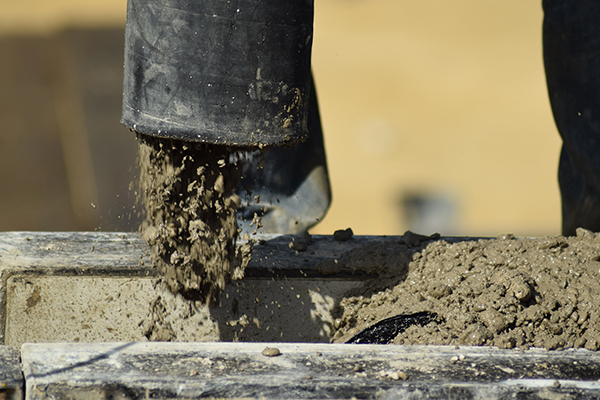Menu
close

Table of Contents
Concrete driveways can add tonnes of kerb appeal and value to your home and they are long-lasting, durable, and easy to maintain. But this is only if you get the installation just right. One of the most important steps in ensuring that your new driveway stays in good condition for longer is applying the concrete sealer. We are going to take a look at why you should apply a sealer and, importantly, why you shouldn't seal concrete too soon.
As a rule of thumb, you should wait about a month from pouring your concrete to applying the sealer to allow time for the concrete to cure. Let's take a look at why.

Concrete is a mix of concrete, water, and aggregate (usually gravel or sand). The first step of creating a concrete driveway is to get the mix just right. The ratio of the different elements needs to be perfect and it needs to be mixed well. Without the right mix of concrete, it won't be as strong as it could be and it could be prone to cracking.
The next step after the concrete has been mixed is to pour the wet concrete into its sub-base. It is important to pour the new concrete as soon as possible after it has been mixed. This step needs to be completed on a dry day because if the wet concrete is poured when it is raining, this can compromise its strength. So it is important before the concrete is even mixed to pay close attention to the weather forecast.
Once you have your newly poured concrete driveway, that isn't the end of the road. Looking forward, it is important that you apply a concrete sealer but many people question exactly when concrete sealers should be applied.
There are a few different types of concrete sealers but they are all used to create a barrier over your new concrete. Unsealed concrete is completely porous and this means that any moisture such as rainwater or oil that ends up on the concrete surface will soak straight into the concrete.
This can be a problem because of the freeze-thaw process. When water soaks into the concrete and then the temperature drops, it can freeze. Frozen liquids expand as they turn to ice, which means that the concrete will also expand. Then when the temperature rises again, the ice will thaw. Over time, this freeze-thaw process will result in tiny cracks which will then start to expand and the concrete will become damaged.
Another purpose of a concrete sealer is to protect the concrete from abrasions. Surface abrasion is always a risk when it comes to concrete, especially concrete in a high-traffic area such as a driveway. Driveway concrete sealer helps to protect the concrete surface from external damage.
To make matters more confusing, there are a few different types of concrete sealer to choose from. They can be broadly separated into reactive chemical sealers and topical sealers and they will interact with the concrete in different ways.
These types of chemically reactive sealers are designed to penetrate the concrete where they will react with the concrete itself to both waterproof and strengthen it. One of the reasons to choose a penetrating sealer is that it doesn't interfere with the way the surface looks and can provide a matte finish.
Rather than penetrating the concrete, topical sealers like acrylic sealers create a thin film over the surface of the concrete. They can be cheaper and easier to apply than penetrating sealers. And rather than taking a day or two to dry, with topical sealers generally taking four hours to become touch dry, the process can be completed much more quickly.
You can also use this type of sealer to add colour to your concrete and provide different types of sheen.
This is another type of topical sealer and can also be used to apply different colours and sheens. Compared to acrylic sealers, however, they provide a much thicker barrier to the surface. This makes them perfect for high-traffic areas like a new concrete driveway. They are also resistant to yellowing from UV damage, making them ideal for outdoor areas.
This is another thicker type of sealer that can be perfect for creating a sturdy driveway. They can be either clear or pigmented and can create a glossy finish, although they are prone to yellowing due to UV rays.

It can be tempting to want to seal concrete immediately after the concrete driveway has been poured, but it is always a mistake to attempt to seal wet concrete. Before sealing, you need to allow the concrete to go through the curing process.
Water is a vital component of new concrete when it comes to the mixing process but once the concrete driveway is poured, it is just as important that no moisture is left before applying sealer. The excess moisture that is still present after a new driveway installation needs to completely evaporate before you seal the concrete. This evaporation is known as the curing process.
As a rule of thumb, it takes approximately 28 days for new concrete to seal. This is why when you look at most concrete sealers, they will recommend that you dealing sealing concrete until 28 days after it has been poured.
If you apply a sealer to damp concrete before the 28 days of the curing process has been completed, then you are less likely to end up with a fresh and sturdy driveway. This is because the sealer application, which is designed to create a waterproof barrier, is just as effective at preventing moisture from escaping as it is at preventing moisture to penetrate the concrete.
Sealed concrete that is still damp, therefore, won't allow the moisture to evaporate through the substrate surface so it stays trapped in the concrete slab. This means that the concrete won't bond as well together, which can make it more fragile, and it also leaves it open to the freeze-thaw process which can lead to both small and large cracks.
It also means that the sealer may not adhere to the concrete evenly. When the substrate is unevenly sealed, this can result in patches of concrete that are exposed to the elements which can mean that you will see areas of discolouration and damage.
Most sealers will take between 24 and 48 hours to fully dry and they mustn't be exposed to rain in the meantime as this will wash the sealer away. While you wait for the sealer to dry, you could use plastic sheeting to ensure that it is protected from the rain. And making sure that you pick a day when there isn't rain forecast for a while is always a good idea when you are getting ready to seal the concrete.
It is always better to apply two coats of sealer that are quite thin rather than trying to apply one thick coat. This can make the sealing process take a lot longer but it will be worth it in the long run as it will mean that your new concrete driveway is properly protected from water absorption because you will be more likely to be able to achieve proper even coverage across the surface.
It is easier to know that topical sealer is dry than penetrating sealers. This is because, with penetrating sealers, while the surface may appear dry, the important chemical reaction may still be taking place beneath the surface.
Drying time will be affected by air temperatures as well as how much moisture is in the air. It is better to err on the side of caution and assume that the sealer isn't dry until well after the recommended drying time.
If the concrete sealer has turned white or cloudy you will know that the sealing process has gone wrong. Specifically, this is known as delamination which means that sealer hasn't adhered properly to the concrete and is lifting. This often happens because you haven't allowed the concrete to cure completely before sealing your concrete.
If you notice staining concrete in patches, this suggests that the sealer hasn't adhered evenly across the surface. These patches where the sealer hasn't worked will allow moisture to penetrate the concrete which can cause both staining and, over time, damage like cracks.
Sealer isn't just important for new concrete. It is also important for old concrete. You should aim to reapply your sealer every one to five years to protect your old concrete for its entire lifespan.
You have to let your concrete cure fully before applying sealer to it. This is because if you don't allow the concrete to become fully cured, too much moisture will be trapped within it and it won't be evaporating correctly. This can mean that your concrete will be more likely to develop cracks and damage, especially in freeze-thaw climates like the UK. Concrete takes approximately 28 days to fully cure and be ready to have sealer applied, but this time can vary depending on the weather conditions. If there is any chance that rain may have penetrated the concrete, you should give it another wee before applying the sealer because concrete is a porous material that readily absorbs liquids, and you will need to wait for them to evaporate as well.